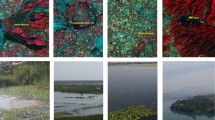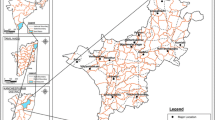Abstract
Various forms of competition for water and amplified agricultural practices, as well as urban development in South Africa, have modified and destroyed natural wetlands and its biodiversity benefits. To conserve and protect wetlands resources, it is important to file and monitor wetlands and their accompanied land features. Spatial science such as remote sensing has been used with various advantages for assessing wetlands dynamic especially for large areas. Four satellite images for 1987, 1997, 2007 (Landsat 5 Thematic Mapper) and 2017 (Landsat 8 Operational Land Imager) were used in this study for mapping wetland dynamics in the study area. The result revealed that the natural landscapes in the area have experienced changes in the last three decades. Dense vegetation, sparse vegetation and water body have increased with about 14% (5976.495 km2), 23% (10,349.631km2) and 1% (324.621) respectively between 1987 and 2017. While wetland features (marshland and quag) in the same period experienced drastic decrease with an area coverage of about 16,651.07 km2 (38%). This study revealed that the shift in the vegetation and water body extents have contributed detrimentally to the drastic declined in the Isimangaliso Wetland Park in recent years. Consequently, this development might have negative effects on the wetland ecosystem and biodiversity and the grave state of the wetland in the study area requires an urgent need for protection of the dregs wetland benefits.








Similar content being viewed by others
References
Abdelaziz R, El-Rahman YA, Wilhelm S (2018) Landsat-8 data for chromite prospecting in the Logar Massif, Afghanistan. Heliyon 4(2):e00542
Adefisan EA, Bayo AS, Ropo OI (2015) Application of geo-spatial technology in identifying areas vulnerable to flooding in Ibadan metropolis. J Environ Earth Sci 5:153–166
Bonan GB (2008) Forests and climate change: forcings, feedbacks, and the climate benefits of forests. Science 320(5882):1444–1449
Canadell JG, Raupach MR (2008) Managing forests for climate change mitigation. Science 320(5882):1456–1457
Chen L, Jin Z, Michishita R, Cai J, Yue T, Chen B, Xu B (2014) Dynamic monitoring of wetland cover changes using time-series remote sensing imagery. Eco Inform 24:17–26
Chopra R, Verma VK, Sharma PK (2001) Mapping, monitoring and conservation of Harike wetland ecosystem, Punjab, India, through remote sensing. Int J Remote Sens 22(1):89–98
Collins SD, Heintzman LJ, Starr SM, Wright CK, Henebry GM, McIntyre NE (2014) Hydrological dynamics of temporary wetlands in the southern Great Plains as a function of surrounding land use. J Arid Environ 109:6–14
Congalton RG, Green K (2002) Assessing the accuracy of remotely sensed data: principles and practices. CRC press, Boca Raton
Davranche A, Lefebvre G, Poulin B (2010) Wetland monitoring using classification trees and SPOT-5 seasonal time series. Remote Sens Environ 114(3):552–562
Ehrenfeld JG (2008) Exotic invasive species in urban wetlands: environmental correlates and implications for wetland management. J Appl Ecol 45(4):1160–1169
Feng J, Ning C, Zhu X, Lin G (2017) Ecological restoration by native-invasive species replacement for mangrove wetlands in Zhangjiang River estuary, Fujian. Oceanologia et Limnologia Sinica/Hai Yang Yu Hu Chao 48(2):266–275
Gabrielsen CG, Murphy MA, Evans JS (2016) Using a multiscale, probabilistic approach to identify spatial-temporal wetland gradients. Remote Sens Environ 184:522–538
Gao BC (1996) NDWI—A normalized difference water index for remote sensing of vegetation liquid water from space. Remote Sens Environ 58(3):257–266
Gómez-Rodríguez C, Bustamante J, Díaz-Paniagua C (2010) Evidence of hydroperiod shortening in a preserved system of temporary ponds. Remote Sens 2(6):1439–1462
Halabisky M, Moskal LM, Gillespie A, Hannam M (2016) Reconstructing semi-arid wetland surface water dynamics through spectral mixture analysis of a time series of Landsat satellite images (1984–2011). Remote Sens Environ 177:171–183
Hansen M (2013) New geographies of conservation and globalisation: the spatiality of development for conservation in the iSimangaliso Wetland Park, South Africa. J Contemp Afr Stud 31(3):481–502
Hart LA, Bowker MB, Tarboton W, Downs CT (2014) Species composition, distribution and habitat types of Odonata in the iSimangaliso Wetland Park, KwaZulu-Natal, South Africa and the associated conservation implications. PLoS One 9(3):e92588
Houlahan JE, Findlay CS (2004) Effect of invasive plant species on temperate wetland plant diversity. Conserv Biol 18(4):1132–1138
Jin H, Huang C, Lang MW, Yeo IY, Stehman SV (2017) Monitoring of wetland inundation dynamics in the Delmarva Peninsula using Landsat time-series imagery from 1985 to 2011. Remote Sens Environ 190:26–41
Lee TM, Yeh HC (2009) Applying remote sensing techniques to monitor shifting wetland vegetation: a case study of Danshui River estuary mangrove communities, Taiwan. Ecol Eng 35(4):487–496
Lillesand T, Kiefer RW, Chipman J (2015) Remote sensing and image interpretation. John Wiley & Sons
Munyati C (2000) Wetland change detection on the Kafue flats, Zambia, by classification of a multitemporal remote sensing image dataset. Int J Remote Sens 21(9):1787–1806
Onamuti OY, Okogbue EC, Orimoloye IR (2017) Remote sensing appraisal of Lake Chad shrinkage connotes severe impacts on green economics and socio-economics of the catchment area. R Soc Open Sci 4(11):171120
Orimoloye IR, Kalumba AM, Mazinyo SP, Nel W (2018a) Geospatial analysis of wetland dynamics: Wetland depletion and biodiversity conservation of Isimangaliso Wetland, South Africa. Journal of King Saud University-Science. https://doi.org/10.1016/j.jksus.2018.03.004
Orimoloye IR, Mazinyo SP, Nel W, Kalumba AM (2018b) Spatiotemporal monitoring of land surface temperature and estimated radiation using remote sensing: human health implications for East London, South Africa. Environ Earth Sci 77(3):77
Orimoloye IR, Mazinyo SP, Nel W, Kalumba AM, Ekundayo OY, Busayo ET, Akinsanola AA, Ololade OO (2019) Spatial assessment of drought severity in Cape Town area, South Africa. Heliyon 5, e02148
Perissinotto R, Miranda NA, Raw JL, Peer N (2014) Biodiversity census of lake St Lucia, iSimangaliso wetland park (South Africa): gastropod molluscs. ZooKeys 440:1–43
Petus C, Lewis M, White D (2013) Monitoring temporal dynamics of great Artesian Basin wetland vegetation, Australia, using MODIS NDVI. Ecol Indic 34:41–52
Rebelo AJ, Morris C, Meire P, Esler KJ (2019) Ecosystem services provided by south African palmiet wetlands: a case for investment in strategic water source areas. Ecol Indic 101:71–80
Reschke J, Hüttich C (2014) Continuous field mapping of Mediterranean wetlands using sub-pixel spectral signatures and multi-temporal Landsat data. Int J Appl Earth Obs Geoinf 28:220–229
Schaffer-Smith D, Swenson JJ, Barbaree B, Reiter ME (2017) Three decades of Landsat-derived spring surface water dynamics in an agricultural wetland mosaic; implications for migratory shorebirds. Remote Sens Environ 193:180–192
Stephen H, Iortyom ET, Ropo OI, Daniel DP (2017) Analysis of the physical growth and expansion of Makurdi town using remote sensing and GIS techniques. Imp J Interdiscip Res 3(7)
Wright C, Gallant A (2007) Improved wetland remote sensing in Yellowstone National Park using classification trees to combine TM imagery and ancillary environmental data. Remote Sens Environ 107(4):582–605
Acknowledgements
Author thank the United State Geological Survey (USGS) for providing satellite imageries and University of Fort Hare, Alice South Africa and the University of the Free State, South Africa for creating an enabling environment for research.
Author information
Authors and Affiliations
Corresponding author
Ethics declarations
Competing interests
The author declare no conflict of interest.
Additional information
Publisher’s note
Springer Nature remains neutral with regard to jurisdictional claims in published maps and institutional affiliations.
Rights and permissions
About this article
Cite this article
Orimoloye, I.R., Mazinyo, S.P., Kalumba, A.M. et al. Wetland shift monitoring using remote sensing and GIS techniques: landscape dynamics and its implications on Isimangaliso Wetland Park, South Africa. Earth Sci Inform 12, 553–563 (2019). https://doi.org/10.1007/s12145-019-00400-4
Received:
Accepted:
Published:
Issue Date:
DOI: https://doi.org/10.1007/s12145-019-00400-4




